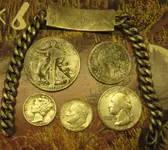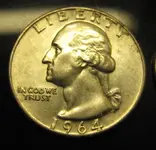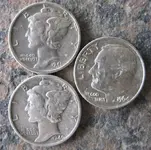ivan salis said:
what brands beside minelab run in the 3 and 15 range ? --- its the signal range that determes the depth that it finds coins at ( in heavily hit areas -- deeper hunters will get "passed over " coins that shallower machines missed -- common sense tells you that but its not just "brand x" that can do it any machine with those deep seeking ranges of 3 /15 can do it in skilled hands) -- thus not the "brand name" that does it .---- detectorist are often worse brand loyality wize than the old "ford vs chevy" truck fans . I'd rather push a _______ than drive a _______ (fill in the blank)
Going technical on me. There's no doubt that a coinshooter machine and a gold machine are two different detectors. I guess this is trying to answer the question, "
Why are newer machines the key to older coins?"
Have to pull out some research now. Let's see what I've got. "Lower frequencies penetrate more deeply but higher frequencies are more sensitive to smaller targets." "Different metals respond better to different frequencies which is why all gold detectors run at 15 khz and up." "The lower the freq. such as 3 Khz will be sensitive in detecting copper and silver targets. Higher freq. such as 15 to 60 Khz will be sensitive to gold targets. That's why most gold detectors sold have a freq. starting at 15 Khz and higher. The detectors sold with general hunting in mind have operating freq. starting from between 5 to 10 Khz."

Minelab’s E-Trac and Explorer use FBS which simultaneously transmits, receives and processes 28 frequencies from 1.5 kHz to 100 kHz.
White’s V3 uses three frequencies 2.5 kHz, 7.5 kHz & 22.5 kHz and operates in the frequency domain only.
White's MXT is 14 kHz, XLT is 6.5 and DFX is dual frequency 3 kHz and 15 kHz
Tesoro models use various
single frequencies 10kHz, 12kHz, 14.3 kHz, and 17.5 kHz. Tejon ranges 17.2-17.6 kHz.
Garrett Ace 250 uses a 6.5 kHz operating frequency.
Fisher CZ3D and Fisher CZ20 are dual frequency, 5 kHz and 15 kHz
Fisher F5 - 7.8 kHz.
Fisher Gold Bug - 71 kHz
So, if you're looking for gold only you want a machine that handles the higher frequencies. Hence, the Fisher Gold Bug at 71 kHz, and PI units, but let's not get into PI units as most of us do not want to do old coin hunting in trashy sites on land with a PI.

I guess the multiple and dual frequency machines will always be able to turn up more targets than a single frequency machine. Theoretically, if you have "cleaned out" a site with your 6.5 kHz White's XLT, and then come along with a 17.5 kHz Tesoro Lobo, you will find targets you missed and that were undetectable with the 6.5 kHz machine.
Sounds like the result of this is that a newer multiple frequency machine will be able to find more targets than the single frequency machines (not necessarily older coins). So the
newer multiple frequency machines, including the
old Fisher CZ and Minelab FBS machines will do better than a single frequency unit.
And this is where I start asking about accuracy of target ID - beeping over metal is not enough, I need to know if it's worth digging or not. How does the number of frequencies affect the target ID? Is a dual frequency (or more) machine going to ID targets more accurately than a single frequency unit? It seems like this would be the case. Certainly in my experience I have found that my Minelab FBS machines are the most accurate ID machines I have ever used, and they are accurate at good depth as well, though any machine will start to drop off on target ID at the edge of it's detection range.
This doesn't speak to the finding gold arguments as we have not discussed how operating frequency affects the detectability of lower conductive metals. Gold is always difficult as it is alloyed with different metals. 10k gold is about 40% gold, so the detectability of a 10k ring is somewhat dependent on what the other 60% of the ring is made of. Due to this variability in alloys, shapes and sizes of gold rings and jewelry, I do not think we can even predict accurate results for one frequency or brand or model of detector being able to find more gold while land hunting homes, parks and schools. Thin gold rings are smaller targets and will be picked up better by a higher frequency, so a higher frequency may have a slight advantage there. Nugget hunting and beach hunting are separate categories of detecting and outside this discussion.
I think it comes down to what we have all been told ad nauseam. The only way to find more gold jewelry type targets on land is by digging more junk and trash targets that fall in the pulltab range on ID machines. If you do not have target ID, you will dig more junk, hence the potential is there for more gold. So, do users of non-ID machines find more gold? Maybe. But their trash-to-treasure ratio is much higher than someone using a target ID machine.
And just a brief not about coils here too, as I feel these play a role as well. The two current most expensive popular machines are the White's V3 and the Minelab E-Trac. Both use DD (double D) coils. In my experience the DD coil covers ground better than a concentric. The Minelab I have found separates signals well, even penny size targets at depth. Better ground coverage with good separation means you will be able to recover more targets and there will be fewer missed targets due to not overlapping sweeps or target masking.
So, why a newer machine?
1. Multiple frequencies = more detected targets
2. More accurate target ID = more signals that say "dig me"
3. DD coils = better coverage and separation






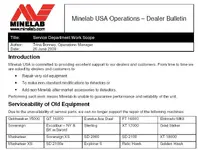


 I had more to say here, but you said it better and without it getting personal, so I'll just leave it at agreeing with you!
I had more to say here, but you said it better and without it getting personal, so I'll just leave it at agreeing with you! 
 I looked at the field tests. The list of differences seems endless. Not the least of which is a meter of some sort. At a minimum I like to have the depth displayed, and in trashy parks having some sort of ID rather than just a discrimination knob.
I looked at the field tests. The list of differences seems endless. Not the least of which is a meter of some sort. At a minimum I like to have the depth displayed, and in trashy parks having some sort of ID rather than just a discrimination knob.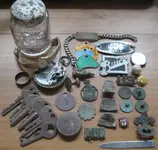
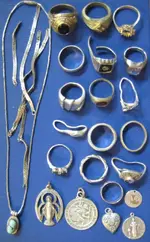
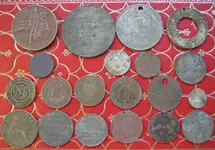

 I am trying to backup/offer proof of my original statement that, yes, newer machines are the key to older coins. I like this debate we have going on
I am trying to backup/offer proof of my original statement that, yes, newer machines are the key to older coins. I like this debate we have going on  I wasn't happy with my finds with my older detector - Fisher CZ3D. I got newer machines (both used, not new, by the way) and I am much happier.
I wasn't happy with my finds with my older detector - Fisher CZ3D. I got newer machines (both used, not new, by the way) and I am much happier.